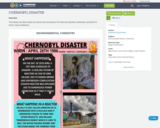
THIS IMAGE HAS BEEN MADE ON CANVA APP EXPLAINING THE PRINCIPLE BEHIND CHERNOBYL DISASTER ITS EFFECT AND AFTERMATH
- Subject:
- Chemistry
- Environmental Science
- Material Type:
- Diagram/Illustration
- Author:
- SHARVANI DESHPANDE
- Date Added:
- 02/28/2021

THIS IMAGE HAS BEEN MADE ON CANVA APP EXPLAINING THE PRINCIPLE BEHIND CHERNOBYL DISASTER ITS EFFECT AND AFTERMATH
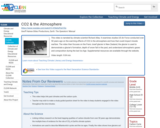
This video is narrated by climate scientist Richard Alley. It examines studies US Air Force conducted over 50 years ago on the warming effects of CO2 in the atmosphere and how that could impact missile warfare. The video then focuses on the Franz Josef glacier in New Zealand; the glacier is used to demonstrate a glacier's formation, depth of snow fall in the past, and understand atmospheric gases and composition during the last Ice Age. Supplemental resources are available through the website.
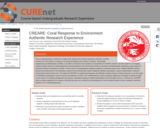
There is growing body of evidence to support that students who directly experience authentic scientific research are more likely to continue onto advanced degrees and careers in Science, Technology, Engineering and Mathematics (STEM). In an effort to introduce more students to the benefits of scientific research we have drawn on an ongoing research project aimed at understanding how Corals Respond to the Environment (CRE) to develop an interdisciplinary laboratory course based on Authentic Research Experiences (ARE). A small cohort of undergraduate students enrolled in a semester-long course, entitled CREARE, perform biochemical experiments in the laboratory, analyze environmental data by R statistical software and prepared a report modeled after a research manuscript to present their work. The impact of CREARE on student learning gains and attitudes towards science is being measured, as is the impact of CREARE on participants' career choices and retention in STEM. This multidisciplinary research program addresses the impact of climate change on the health of a critically endangered coral species, ultimately leading to a better stewardship of this invaluable resource. Furthermore, CREARE offers a unique experience for students, one that may serve as a model for the development of more research-based courses, leading to improved retention in our STEM departments.
(Note: this resource was added to OER Commons as part of a batch upload of over 2,200 records. If you notice an issue with the quality of the metadata, please let us know by using the 'report' button and we will flag it for consideration.)
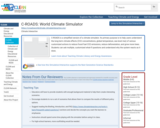
C-ROADS is a simplified version of a climate simulator. Its primary purpose is to help users understand the long-term climate effects (CO2 concentrations, global temperature, sea level rise) of various customized actions to reduce fossil fuel CO2 emissions, reduce deforestation, and grow more trees. Students can ask multiple, customized what-if questions and understand why the system reacts as it does.

Produto Técnico do Programa de Pós-Graduação em Rede Nacional para o Ensino das Ciências Ambientais - Pólo Universidade Federal de Sergipe.
O curso de Agentes Mirins Disseminadores da Cidadania Ambiental é um instrumento para o ensino das ciências ambientais, que versa o envolvimento dos participantes na construção coletiva do processo de ensino-aprendizagem, unindo a teoria-prática acerca dos conhecimentos apreendidos que são pautados nas questões ambientais. O seu desígnio principal é fomentar a sensibilização dos sujeitos para a participação no contexto da sociedade, questionando atitudes, valores, além de propor novas práticas acerca da problemática ambiental.
Trata-se de instrumento educacional para o estimulo a reflexão crítica, bem como, fomentar nos sujeitos a atuação participante e protagonista das problemáticas que englobem ilimitadas realidades. Assim sendo, o público alvo abarca os estudantes e os membros da comunidade ribeirinha, compreendendo que os conteúdos trabalhados podem ser adaptados e desenvolvidos dentro de infinitas realidades de interesse local e global.
Nesse sentido, vislumbramos que os sujeitos ao participarem da construção do vídeo documentário e assistirem ao seu produto final – o vídeo documentário, cuja dedicação em pensar e articular cada etapa, fomente reflexões acerca do que foi trabalhado durante todo processo de construção, sendo assim, capazes de disseminar de forma potente a mensagem de sensibilização das problemáticas socioambientais que precisão ser sanadas no lugar onde vivem. Versará também, provocar impacto visual e emocional nos participantes, pois, na atualidade é comum, os meios de comunicação e as escolas na divulgação e nas análises dos problemas tragam diversas realidades em escalas distantes das vivenciadas no espaço social dos sujeitos, porém assistir a sua realidade fará com que os envolvidos se sintam parte do problema, e posteriormente partir em busca por soluções para sanar as problemáticas encontradas, aproximando aquele que fala daquele que assiste.
Vídeo Documentário construído durante o curso de Agentes Mirins Disseminadores da Cidadania Ambiental por alunos e alunas da Escola Municipal Barquinho Amarelo, localizada no povoado São Braz, Nossa Senhora do Socorro, Sergipe.
Duração: 08min30seg
Roteiro e Filmagem: Alunos e Alunas do 5º ano do ensino fundamental, 2017
Edição e Narração: Laysa da Hora Santos
Apoio Técnico: Thais Moura dos Santos e Jacqueline Bispo Santana
Ilustrações: Emanuella Santos de Carvalho

This in class activity allows students to calculate rates of change from graphs of glacial-interglacial temperatures and CO2 and modern temperatures and CO2.
(Note: this resource was added to OER Commons as part of a batch upload of over 2,200 records. If you notice an issue with the quality of the metadata, please let us know by using the 'report' button and we will flag it for consideration.)

Prior to assigning this activity in lecture, students gather information about their personal energy consumption so that they can calculate their personal carbon footprint. Specifically they need to determine the gas mileage of their vehicle, the average number of miles they drive in a month, and bring to class an electric bill and a natural gas bill from their apartment. I provide the appropriate information for students living in dorms. Their task during the class period is to assemble this information and calculate how much carbon their activities are responsible for generating. Once this portion of the assignment is complete, they investigate options for reducing their carbon emissions and the costs of those options. The pros and cons of carbon-reduction strategies form the basis for the class discussion. Lastly, students are asked to brain storm a list of potential carbon sources that are not included in this simple exercise, such as the carbon required to make the things we buy (computers, edible dinosaurs, q-tips, etc.).
(Note: this resource was added to OER Commons as part of a batch upload of over 2,200 records. If you notice an issue with the quality of the metadata, please let us know by using the 'report' button and we will flag it for consideration.)
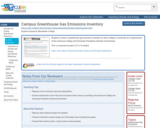
Students conduct a greenhouse gas emission inventory for their college or university as a required part of the American College and University Presidents Climate Commitment.
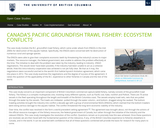
The case study involves the B.C. groundfish trawl fishery, which came under attack from ENGOs in the mid-2000s for destruction of the aquatic habitat. Specifically, the ENGOs were concerned with he destruction of numerous coral and sponge species. The ENGOs were able to give their complaints economic teeth by threatening the industry’s access to major markets. The resource manager, the federal government, was unable to address the problem effectively at the time. The initiative to deal with the problem was taken by the industry, leading to industry –ENGO negotiations. This would never have been possible, if the industry had been unable to act as a cohesive whole. How this intra-industry cooperation was achieved is not yet fully clear. Be that as it may, the negotiations were successful and led to the world’s first habitat bycatch limitation agreement, which came into place in 2012. The case study examines the negotiations and the degree of success of the agreement. It raises the question of the applicability of the B.C. experience to other fisheries in Canada and the rest of the world.
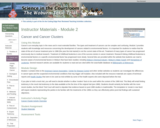
Cancer is an everyday topic in the news and in most extended families. The types and treatment of cancers can be complex and confusing. Module 2 provides students with knowledge and resources concerning the development of cancers related to environmental factors. It is important for students to realize that the state-of-the-art of cancer treatment prior to 1986 (the year the trial started) is not the current state-of-the-art. Treatment of many types of cancer has progressed enormously due to medical research. Treatment of childhood leukemia is one of the success stories in cancer treatment. Research linking childhood leukemia to environmental factors or a specific environmental factor has progressed more slowly. Several links are provided within the website that students can read to become aware of environmental factors in Woburn that have been studied, including Woburn Chemical Industry, Woburn's Water Supply and Hematology of Leukemia. Several research articles are available for students to read and are cited within the searchable database at Bibliography & References.
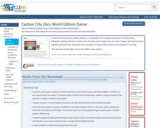
In this interactive game, players develop a sustainable city by greening transport, transforming industries, getting citizens on board, and showing world leaders how it's done. Players will need to bring together governments, industries, and the public to bring carbon levels to zero before it's too late.
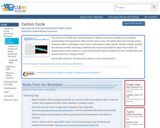
This activity from NOAA Earth System Research Laboratory introduces students to the scientific understanding of the greenhouse effect and the carbon cycle. The activity leads them through several interactive tasks to investigate recent trends in atmospheric carbon dioxide. Students analyze scientific data and use scientific reasoning to determine the causes responsible for these recent trends. By studying carbon cycle science in a visual and interactive manner, students can learn firsthand about the reasons behind our changing climate.
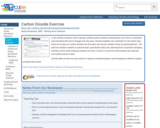
In this activity, students work in groups, plotting carbon dioxide concentrations over time on overheads and estimating the rate of change over five years. Stacked together, the overheads for the whole class show an increase on carbon dioxide over five years and annual variation driven by photosynthesis. This exercise enables students to practice basic quantitative skills and understand how important sampling intervals can be when studying changes over time. A goal is to see how small sample size may give incomplete picture of data.
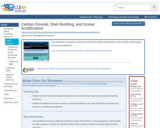
This interactive visualization explains the chemical relationship between carbon dioxide, shell building, and ocean acidification.
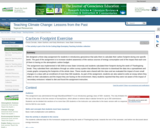
Step 1. Students are asked to keep track of their energy use from a variety of sources (heating/cooling, electricity, transportation, secondary emissions, etc) during the 9 days of Thanksgiving break, when many of them are likely to travel. They use the total for the 9 days that they calculated using an online calculator to estimate their yearly footprint and compare it to US and world averages. For most of them, the amount of carbon emitted during those 9 days is quite large because of airplane travel or long-distance driving. However, using a week of break when many students will travel allows them to become aware of the significance of transportation in carbon emissions. We provided a table with electricity and heating/cooling bills for various residence halls for students who stay on campus during the break.
Step 2. Students complete an online survey where they are asked to enter the values that they have obtained for the various components of the calculator, perform some simple calculations and compare their annual footprint to the U.S. average. We used SurveyGizmo for the survey because it allows to download the data in a spreadsheet format and has some limited plotting features. The free version allows a maximum of 250 submissions, the Basic version ($19 per month, can be canceled at any time) has unlimited submissions.
Step 3. Students write an essay through BlackBoard/WebCT (Assignment). A few guiding questions are provided for this essay where students reflect on the results of their impact on the global carbon budget, what they found surprising, and if they plan to make any changes to their lifestyle to limit their impact. No length limit is set for the essay.
The guidelines and components of this assignment are available on a wiki page. The three steps can be implemented in BlackBoard/WebCT as a Lesson Plan with links to the online calculator (step 1), to the survey (step 2), and to the Assignment/essay (step 3).
(Note: this resource was added to OER Commons as part of a batch upload of over 2,200 records. If you notice an issue with the quality of the metadata, please let us know by using the 'report' button and we will flag it for consideration.)
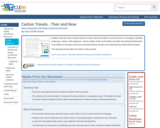
Students play the role of carbon atoms to learn about the carbon cycle and how it is changing. Students create two carbon cycle diagramsâvisual models of the cycle before and after the Industrial Revolution. They reflect on the game and how scientists believe humans are impacting this critical Earth system.
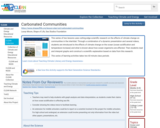
This series of two lessons uses cutting-edge scientific research on the effects of climate change on communities in the intertidal. Through a combination of a dynamic presentation and several videos, students are introduced to the effects of climate change on the ocean (ocean acidification and temperature increase) and what is known about how ocean organisms are affected. Then students read and interpret graphs and construct a scientific explanation based on data from this research.

In this assignment, students in small groups are asked to interpret and explain a figure depicting one aspect of marine carbon biogeochemistry. Then a representative of each group explains the figure to the class.
(Note: this resource was added to OER Commons as part of a batch upload of over 2,200 records. If you notice an issue with the quality of the metadata, please let us know by using the 'report' button and we will flag it for consideration.)

This course has been designed as a seminar to give students an understanding of how scientists with medical or scientific degrees conduct research in both hospital and academic settings. There will be interactive discussions with research clinicians and scientists about the career opportunities and research challenges in the biomedical field, which an MIT student might prepare for by obtaining an MD, PhD, or combined degrees. The seminar will be held in a case presentation format, with topics chosen from the radiological sciences, including current research in magnetic resonance imaging, positron emission tomography and other nuclear imaging techniques, and advances in radiation therapy. With the lectures as background, we will also examine alternative and related options such as biomedical engineering, medical physics, and medical engineering. We'll use as examples and points of comparisons the curriculum paths available through MIT's Department of Nuclear Science and Engineering. In past years we have given very modest assignments such as readings in advance of or after a seminar, and a short term project.
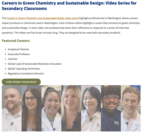
The Careers in Green Chemistry and Sustainable Design video series highlight professionals in Washington whose careers impact products or chemicals used in Washington. Each of these videos highlight a career that connects to green chemistry and sustainable design. In each video, the professionals share their reflections in response to a series of interview questions. The videos are five to ten minutes long. They are designed to be used with secondary students.
It includes an activity guide to support teachers with using the video series with students.
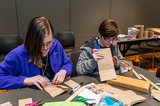
This resource provides a list of videos and other resources that can be used in career exploration with secondary students. Resources highlight careers that make use of green chemistry and sustainable design principles. The list includes several Washington career opportunities.
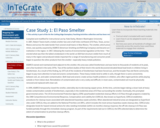
Compiled and modified for instructional use by: Kate Darby, Western Washington University
In 1887, Robert Towne built a metals smelter two and a half miles northwest of El Paso, Texas, across the river from Ciudad Juarez in Mexico and across the state border from several small towns in New Mexico. The smelter, which processed metal ore from regional mines, was quickly acquired by ASARCO (American Smelting and Refining Company) and became an important visual and economic institution in the region. In 1967, following the mantra of environmental regulation at the time—"the solution to pollution is dilution"—ASARCO erected what was then the tallest smokestack in the world: an 828-foot structure visible from much of the region. While the facility provided jobs to many in the region and produced metals important for a range of manufacturing and consumer products, by the 1970s, residents and scientists began to question the other products from the smelter—especially heavy metals pollution.
This case study includes discussion questions and data sources for further information.
(Note: this resource was added to OER Commons as part of a batch upload of over 2,200 records. If you notice an issue with the quality of the metadata, please let us know by using the 'report' button and we will flag it for consideration.)
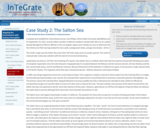
Compiled and modified for instructional use by: Lisa Phillips, Illinois State University, llphill@ilstu.edu
On September 10, 2012, several million southern California residents reacted with alarm to an unfamiliar noxious scent. The Air Quality Management District officials in the Los Angeles region were initially at a loss to determine the odor's source. Investigators from Ventura to Palm Springs looked for toxic spills, sewage plant leaks, and gas line breaks—all for naught.
The smell's origin was the Salton Sea more than 150 miles away and not usually upwind. The smell of an algal bloom and subsequent massive fish kill released odor molecules redolent with the stench of environmental decay.
This case study includes discussion questions and data sources for further information.
(Note: this resource was added to OER Commons as part of a batch upload of over 2,200 records. If you notice an issue with the quality of the metadata, please let us know by using the 'report' button and we will flag it for consideration.)
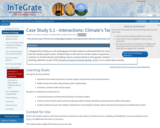
I designed this activity as a role-playing game to help students understand both the concept of climate modeling and how the climate system works. Students take on the role of a climate system component, examining their personal reactions to climate stimuli and building a future scenario based on their group's reactions. You can implement this teaching collection as part of the Climate of Change InTeGrate Module, Unit 5, or as a stand-alone activity.
(Note: this resource was added to OER Commons as part of a batch upload of over 2,200 records. If you notice an issue with the quality of the metadata, please let us know by using the 'report' button and we will flag it for consideration.)

In this activity, students consider how several communities are adapting to climate change-related problems including drought's impacts on agriculture, loss of assets due to climate-related hazards, freshwater availability, and extreme heat waves. They will read brief case studies about agro-forestry, insurance strategies, the "Room for the River" program in the Netherlands, water storage from retreating glaciers, and city planning for heat waves. Based on these examples and knowledge of their own community, they will suggest possible adaptation strategies that will be most beneficial to their area.
(Note: this resource was added to OER Commons as part of a batch upload of over 2,200 records. If you notice an issue with the quality of the metadata, please let us know by using the 'report' button and we will flag it for consideration.)

This animation illustrates how the hardiness zones for plants have changed between 1990 and 2006 based data from 5,000 National Climatic Data Center cooperative stations across the continental United States.
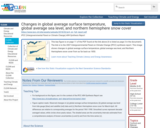
Key figure from the 2007 Intergovernmental Panel on Climate Change (IPCC) report that shows changes in global average surface temperature, global average sea level, and Northern Hemisphere snow cover from as far back as 1850.
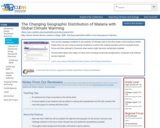
This activity engages students in the analysis of climate data to first find areas in the southern United States that are now close to having conditions in which the malaria parasite and its mosquito hosts thrive and then attempt to forecast when areas might become climatically suitable.
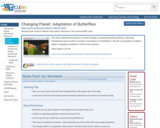
This video addresses the impact of climate change on several butterfly populations. Warming temperatures lead to shifts in location of populations of butterflies or die-offs of populations unable to adapt to changing conditions or shift to new locations.
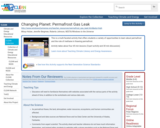
This is a multi-faceted activity that offers students a variety of opportunities to learn about permafrost and the role of methane in thawing permafrost.

This video discusses the social and economic impacts (worldwide and in the US) of sea level rise caused by global warming (aired April 1, 2011). Note: you may need to scroll down the Changing Planet video page to get to this video.
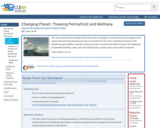
This video examines the thawing of permafrost due to changes in climate and shows examples of the impacts that warming temperatures have on permafrost in the Arctic, including the release of the greenhouse gas methane. Dramatic results are shown, including sink holes forming on the landscape and beneath buildings, roads, and other infrastructure, causing some communities to relocate.

This is an undergraduate introductory laboratory subject in ocean chemistry and measurement. There are three main elements to the course: oceanic chemical sampling and analysis, instrumentation development for the ocean environment, and the larger field of ocean science.
This course is offered through The MIT/WHOI Joint Program. The MIT/WHOI Joint Program is one of the premier marine science graduate programs in the world. It draws on the complementary strengths and approaches of two great institutions: the Massachusetts Institute of Technology (MIT) and the Woods Hole Oceanographic Institution (WHOI).
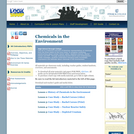
This kit is a historical overview of American representations of chemicals from the three sisters to the Love Canal. It compares conflicting constructions about nuclear reactor safety, depleted uranium, Rachel Carson and DDT. Through analyzing diverse historic and contemporary media messages, students understand changing public knowledge, impressions and attitudes about chemicals in the environment.

This course addresses the challenges of defining a relationship between exposure to environmental chemicals and human disease. Course topics include epidemiological approaches to understanding disease causation; biostatistical methods; evaluation of human exposure to chemicals, and their internal distribution, metabolism, reactions with cellular components, and biological effects; and qualitative and quantitative health risk assessment methods used in the U.S. as bases for regulatory decision-making. Throughout the term, students consider case studies of local and national interest.

This course addresses the challenges of defining a relationship between exposure to environmental chemicals and human disease. Course topics include epidemiological approaches to understanding disease causation; biostatistical methods; evaluation of human exposure to chemicals, and their internal distribution, metabolism, reactions with cellular components, and biological effects; and qualitative and quantitative health risk assessment methods used in the U.S. as bases for regulatory decision-making. Throughout the term, students consider case studies of local and national interest.

A Chemistry Perspective for discussion of Environmental Issues
Short Description:
Chemistry and the Environment is designed as a resource to accompany lectures for an Environmental Studies course that explores current environmental issues from a chemical perspective. It was edited from the OpenStax book Chemistry 2e.
Long Description:
Chemistry and the Environment is designed as a resource to accompany lectures for an Environmental Studies course that explores current environmental issues from a chemical perspective. It was edited from the OpenStax book Chemistry 2e.
Chemistry 2e is designed to meet the scope and sequence requirements of the two-semester general chemistry course. The textbook provides an important opportunity for students to learn the core concepts of chemistry and understand how those concepts apply to their lives and the world around them. The book also includes a number of innovative features, including interactive exercises and real-world applications, designed to enhance student learning. The second edition has been revised to incorporate clearer, more current, and more dynamic explanations, while maintaining the same organization as the first edition. Substantial improvements have been made in the figures, illustrations, and example exercises that support the text narrative. Changes made in Chemistry 2e are described in the preface to help instructors transition to the second edition. The first edition of Chemistry by OpenStax is available in web view here.
Word Count: 166210
ISBN: 978-1-7777612-7-1
(Note: This resource's metadata has been created automatically by reformatting and/or combining the information that the author initially provided as part of a bulk import process.)

An infographic presentation on the chernobyl nuclear disaster

In this video clip from Earth: The Operators' Manual, host Richard Alley discusses China's efforts to develop clean energy technologies and to reduce CO2 in the atmosphere, by building coal plants using CO2 sequestration technology. (scroll down page for video)
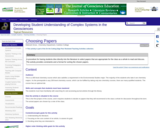
In an upper-level seminar course, students bear significant responsibility for their learning. This activity provides the framework to help them identify the exact topics that they will discuss throughout a course in Environmental Analysis. The students are given constraints so that they don't either wander completely aimlessly through the environmental literature or pick only papers on their favorite topic. They are instead asked to dip into the literature to find papers that deal with analysis of pollutants in air, water, and solid matrices, and to have at least one that is relevant to climate change.
(Note: this resource was added to OER Commons as part of a batch upload of over 2,200 records. If you notice an issue with the quality of the metadata, please let us know by using the 'report' button and we will flag it for consideration.)

Ce tableau présente la classification des couples acide/base.
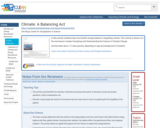
In this activity students learn how Earth's energy balance is regulating climate. This activity is lesson 4 in the nine-lesson module Visualizing and Understanding the Science of Climate Change.

This interactive role-playing simulation is conducted as a simulated emergency climate summit organized by the United Nations that convenes global stakeholders to establish a concrete plan that limits warming to Paris Agreement goals. This game is a fun format for large groups to explore climate change solutions and see what it would really take to address this global challenge.

Bell Telephone Science Hour produced this video in 1958, explaining how the production of CO2 from factories and automobiles is causing the atmosphere to warm, melting the polar ice caps, and causing the sea level to rise.

In a world where climate change has never been experienced, it is time to do something. This poster aims to encourage people to act, by raising awareness of the importance of talking about climate change. This poster highlights the respect for nature by using powerful images and colors.

This course has been designed to help professionals working across multiple disciplines bring a climate change adaptation lens to their current and future projects.
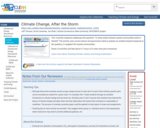
This 3-activity sequence addresses the question: "To what extent should coastal communities build or rebuild?" The activity uses social science and geoscience data to prepare an evidence-based response to the question, in targeted US coastal communities.
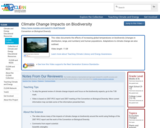
This video documents the effects of increasing global temperatures on biodiversity (changes in distribution, range, and numbers) and human populations. Adaptations to climate change are also outlined.
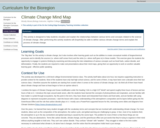
This activity is designed to help students visualize and explain the relationships between various terms and concepts related to the science of climate change. After performing this activity students will (hopefully) be able to define various climate change terms and explain the process of climate change.
(Note: this resource was added to OER Commons as part of a batch upload of over 2,200 records. If you notice an issue with the quality of the metadata, please let us know by using the 'report' button and we will flag it for consideration.)

This poster is about Climate Change: A Call to Action. This material can be used in mitigating Climate Change around the world.
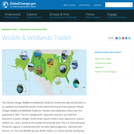
Use this site to learn about the science of climate change and its potential effects on our nation's wildlife and their habitats.
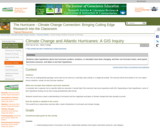
Students are asked to make a general hypothesis about whether Atlantic hurricane have been changing over time in response to recent climate change. It is expected that at an introductory level with only the most basic background instruction, students will focus on numbers, locations, or intensities of hurricanes. Example hypotheses might be
The numbers of hurricanes are increasing (or decreasing)
Hurricanes are becoming more intense
Hurricanes are forming in new locations
Hurricane season is lengthening
They are then asked to develop more pointed questions that they can test. Some example questions for each hypothesis are given below:
Hypothesis 1 might lead to questions like "More hurricanes (or tropical storms) are forming each year" or "More hurricanes are striking land each year."
Hypothesis 2 might lead to questions such as "The maximum wind speed for hurricanes is increasing" or "The minimum barometric pressure is decreasing."
Hypothesis 3 might lead to questions like "Hurricanes are forming further north."
Hypothesis 4 might lead to questions such as "Hurricanes are forming earlier and later."
To answer these questions would require students to understand some background about hurricanes, like how many typically occur in the past (which leads to questions about data collection and observing hurricanes), how hurricane intensity is measured, or at what latitudes hurricanes typically form.
Then they are given a table or map data (derived from NOAA GIS data of hurricane tracks and intensity) to test their hypotheses.
The results of their inquiries and data collection will be shared with the class as parts of small groups initially, and will culminate as a small group presentation.
(Note: this resource was added to OER Commons as part of a batch upload of over 2,200 records. If you notice an issue with the quality of the metadata, please let us know by using the 'report' button and we will flag it for consideration.)

Students will learn how species shift along environmental gradients (temperature, precipitation, and vegetation) in response to climate change over the last 20,000 years, from the time of the Last Glacial Maximum through deglaciation and the Holocene. The activity involves making maps of species distribution using the Neotoma database. Students will develop skills in data analysis and interpretation over a two-to-four class arc.
(Note: this resource was added to OER Commons as part of a batch upload of over 2,200 records. If you notice an issue with the quality of the metadata, please let us know by using the 'report' button and we will flag it for consideration.)
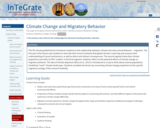
In this 50-minute guided lecture, students learn the peculiar threats to migratory animals, given the projected spatial variability of climate change on the planet. This activity uses a climate departure analysis to assess threat to the monarch butterfly.
(Note: this resource was added to OER Commons as part of a batch upload of over 2,200 records. If you notice an issue with the quality of the metadata, please let us know by using the 'report' button and we will flag it for consideration.)
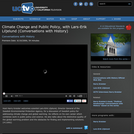
Host Harry Kreisler welcomes scientist Lars-Erik Liljelund, Director General of the Swedish Environmental Protection Agency, for a discussion of Swedish policy for addressing climate change and global warming. He reflects on his own career which combines work in public policy and science. He also talks about the distinctive quality of the global warming problem and the obstacles for finding and implementing solutions. 54 min)
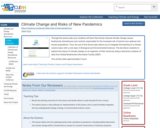
Through this lesson plan your students will learn that human induced climate change causes biodiversity disturbances and could be responsible for the increased risk of animal virus spillover into human populations. Thus, the use of this lesson plan allows you to integrate the teaching of a climate science topic with a core topic in Biological and Environmental Sciences. The lab allows students to explore the impact of climate change on an organism of their choice by doing a diachronic analysis of data from Global Biodiversity Information Facility (GBIF).
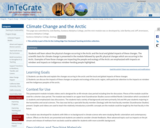
Students will learn about the physical changes occurring in the Arctic and the local and global physical, climatic, and human impacts of these changes.
(Note: this resource was added to OER Commons as part of a batch upload of over 2,200 records. If you notice an issue with the quality of the metadata, please let us know by using the 'report' button and we will flag it for consideration.)
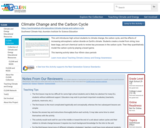
This unit introduces high school students to climate change, the carbon cycle, and the effects of increasing atmospheric carbon dioxide on Earth's climate. Students create a model from string, toss bean bags, and sort chemical cards to review key processes in the carbon cycle. Then they quantitatively model the carbon cycle by playing a board game.
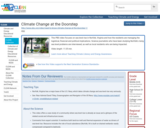
This PBS video focuses on sea level rise in Norfolk, Virginia and how the residents are managing the logistical, financial and political implications. Science journalists who have been studying Norfolk's rising sea level problems are interviewed, as well as local residents who are being impacted.
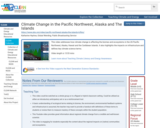
This video addresses how climate change is affecting the biomes and ecosystems in the US Pacific Northwest, Alaska, Hawaii and the Caribbean Islands. It also highlights the impacts on infrastructure and defines key climate science terms.
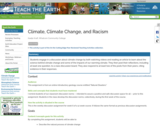
Students engage in a discussion about climate change by both watching videos and reading an article to learn about the science behind climate change and some of the impacts of our warming climate. They then post their reflections, including at least one question, to a class discussion board. They also respond to at least two of the posts from their peers, citing evidence in their responses.
(Note: this resource was added to OER Commons as part of a batch upload of over 2,200 records. If you notice an issue with the quality of the metadata, please let us know by using the 'report' button and we will flag it for consideration.)
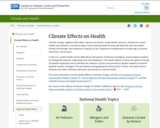
This resource talks about multiple topics regarding the climate and health.

This lab uses the Climate Engine website to introduce students to Geographical Information Software, climate data, cloud processing, and time-series analysis using common environmental remote sensing data products
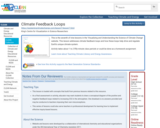
This is the seventh of nine lessons in the 'Visualizing and Understanding the Science of Climate Change' website. This lesson addresses climate feedback loops and how these loops help drive and regulate Earth's unique climate system.

This is a lesson to help students write climate fiction to create conscience about climate change.
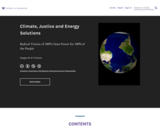
Radical Visions of 100% Clean Power for 100% of the People
Word Count: 70279
(Note: This resource's metadata has been created automatically by reformatting and/or combining the information that the author initially provided as part of a bulk import process.)

Weaving Climate, Environmental Justice and Civic Engagement into Your Courses
Short Description:
As the inequitable impacts of climate change become more evident and destructive, it is essential for climate and environmental justice, as well as methods of civic engagement, to be taught at a high-level to college-level students. This book provides real examples of how professors at the University of Washington integrated these critical issues into their teachings, both in targeted lessons and as throughlines across an entire course. These samples of how environmental and climate justice have been successfully integrated into higher-level education can serve as both a record of the UW's progress towards centering JEDI at the heart of all students, and as a model for future instructors to use as they work to incorporate more aspects of justice and engagement into their own material.
Long Description:
With the increased effect of anthropogenic climate change, the impact of environmental issues on human societies has never been more essential to understand. With science-backed research showcasing that human activities are actively worsening the effect of many environmental issues including severe temperatures, natural disasters, and biodiversity loss, there is severe need for all, whether we are scientists, activists, educators, or policy-makers, to take action. However, the global nature of both our society and the dangers we are facing necessitates careful consideration in analyzing and combatting environmental issues in a modern world. To properly adapt to and mitigate these issues, which may directly target specific communities or affect societies across the globe, not only do we need a proper grasp of environmental and climate science, but we need to ensure that solutions are mindful of the communities and ecosystems that are affected. We must not be content with climate and environmental solutions that fail to consider diversity, equity, inclusion, and accessibility as key tenets. In short, justice must be at the heart of our climate and environmental work going forward.
Yet, facilitating just solutions cannot be done while the institutions that teach the next generation fail to highlight climate and environmental justice in their teachings. Without a natural and focused inclusion of DEIA values in environmental courses in higher education, there is reduced capacity for students who wish to engage to garner an understanding of what just solutions look like and how to implement them. This book seeks to remedy that gap.
Throughout this book, we synthesize the current efforts towards including climate, environmental justice, and civic engagement in courses taught at the University of Washington – Seattle. These examples range from specific lessons on environmental injustice to course-long integration of climate justice values, and include course details, lesson plans, and other resources provided by course instructors in an easy-to-access format. The chapters in this book each constitute a real method of integrating climate and environmental justice into a course, and thus provide a bounty of instruction for increasing the inclusion of justice in course material for instructors across any discipline. Lessons will be regularly added to the book as they are implemented and adapted. The existence of this book marks not only the history of environmental justice in courses at the UW, but also the emphasis on the topic of justice that the college is placing in the current day, as well as serving as a guide or model for instructors to use as more courses begin to fully integrate justice into their curriculum. Through this work, we can be more reliably assured that the people we are training to practice civic engagement and climate and environmental action can not just protect the planet, but preserve the life of the people, communities, and ecosystems who depend on it.
This book has been created with support from the University of Washington Program on Climate Change, the UW Program on the Environment, and the University of Washington College of the Environment, especially from material created at our annual Climate and Environmental Justice Faculty Institute.
Word Count: 9944
(Note: This resource's metadata has been created automatically by reformatting and/or combining the information that the author initially provided as part of a bulk import process.)
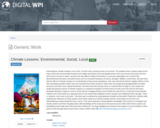
Anthropogenic climate change is one of the, if not the most, pressing issues of our times. The problems that it causes range across many social and environmental domains from habitat and species loss and displacement to the more human and social concerns and issues of access to water, sea level rise that affects coastal communities, to economic degradation as a result of the aforementioned and other connected issues such as increased frequency of storms, droughts, wildfires, and the like. We also know that the affects of climate change are not distributed evenly across populations- that many will and do feel the negative effects of this slow developing problem earlier and more intensely than others based on where they are located both geographically and within economic and other socio-cultural hierarchies. We also know that recently, there is a marked effort to begin to move away from simply decrying the horrors of climate change to a continued recognition of those horrors as they exist now and into the future alongside attempts to begin to come to terms with the changing climate and to rethink the ways that our social and environmental relations and communities are organized with an eye toward both adapting to these changes and mitigating further damage. There is, however, much work to be done. This book was co-authored by undergraduate students at Worcester Polytechnic Institute while exploring the influences of Earth systems and human systems on climate change and the communities at most risk in an interdisciplinary project-based first year course. This course attempts to bring together knowledge of the science of ecological and climate systems and their changing status with knowledge of the social and communal structures within which these systems are embedded and through which they have been influenced. The book highlights key interests and insights of current students in their quest to think through these issues and to create a better world.
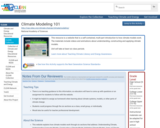
This resource is a website that is a self-contained, multi-part introduction to how climate models work. The materials include videos and animations about understanding, constructing and applying climate models.
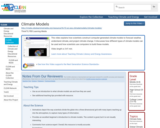
This video explains how scientists construct computer-generated climate models to forecast weather, understand climate, and project climate change. It discusses how different types of climate models can be used and how scientists use computers to build these models.
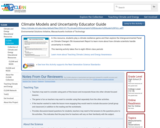
In this resource, students play a climate resilience game and then explore the Intergovernmental Panel on Climate Change's 5th Assessment Report to learn more about how climate scientists handle uncertainty in models.
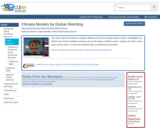
This video offers the audience a specific definition of the term 'global climate models'. It highlights and defines key climate modeling concepts such as the physics of fluids, carbon, nitrogen and water cycles, paleo climate data vs current and projected data vs predictive and real data.
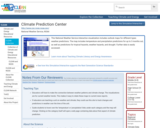
This National Weather Service interactive visualization includes outlook maps for different types weather predictions. The map includes temperature and precipitation predictions for up to 3 months out, as well as predictions for tropical hazards, weather hazards, and drought. Further data is easily accessed.
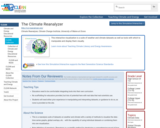
This interactive visualization is a suite of weather and climate datasets as well as tools with which to manipulate and display them visually.

This is a rich compilation of resources and tools to help decision-makers across the US identify their local climate threats and vulnerabilities and reduce their risks from impacts of climate variability and change. As part of President Obama's Climate Action Plan, the toolkit was developed by NOAA in partnership with NASA and other departments and agencies in the U.S. Global Change Research Program.
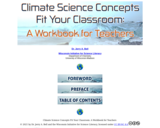
This Workbook is designed to be used by college faculty and secondary school science teachers. To teach our students and also to share this knowledge with the public and be credible, science teachers at all levels must acquire a good grasp of the science of climate change and must also develop skills for affecting attitudes in and out of the classroom.
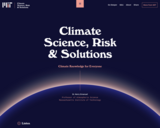
The goal of this site is to summarize the most important lines of evidence for human-caused climate change. It confronts the stickier questions about uncertainty in our projections, engages in a discussion of risk and risk management, and concludes by presenting different options for taking action. This site sticks to the facts and does not get into politics. We hope that the facts prepare you for more effective conversations with your community about values, trade-offs, politics, and actions.
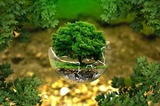
This learning resource will engage you and your colleagues in learning more about the importance of learning and teaching climate science as part of the Next Generation Science Standards (NGSS). You will hear from multiple stakeholders about the importance and impact of learning about climate science, as well as engage with learning tools and reflection questions to deepen your learning and position you to take action in your setting. We envision this professional learning taking place in an ongoing community of practice. We encourage you to determine and proceed at your own pace that reflects the needs of your team.
Image by ejaugsburg from Pixabay

This series of four animations shows how some of the key indicators of climate change (average global temperature, sea level, sea ice extent, carbon emissions) have changed in Earth's recent history.

In this activity, students work with climate data from the tropical Pacific Ocean to understand how sea-surface temperature and atmospheric pressure affect precipitation in the tropical Pacific in a case study format.
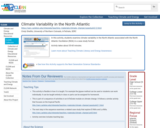
In this activity, students examine climate variability in the North Atlantic associated with the North Atlantic Oscillation (NOA) in a case study format.
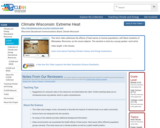
This short video addresses the effects of heat waves on human populations, with Black residents of Milwaukee, Wisconsin, as the visual subjects. The narrative is done by a young spoken- word artist.

This is an interactive graph that involves records of ice cover in two Wisconsin lakes - Lake Mendota and Lake Monona - from 1855-2010.

This video provides background information and teaching tips about the history and relevance of phenology and seasonal observations of plants and animals within the context of rural Wisconsin.
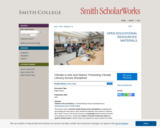
This resource aims to promote climate literacy across disciplines by exploring and documenting the many ways in which climate has impacted, and continues to influence life on Earth. To do so, this resource focuses on connecting historical events and works of art, literature and music, among other aspects of human society and culture, to specific climate events in Earth’s history, and explains the science behind the climatic changes.
As we move into an increasingly uncertain future, understanding the effects of past climate fluctuations is becoming more important for coping with present and future climate changes initiated and accelerated by human activities.
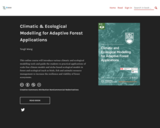
Short Description:
This online course will introduce various climatic and ecological modelling tools and guide the students to practical applications of scale-free climate models and niche-based ecological models in forest and ecological (such as birds, fish and animals) resource management to increase the resilience and viability of forest ecosystems.
Long Description:
This online course will introduce various climatic and ecological modelling tools and guide the students to practical applications of scale-free climate models and niche-based ecological models in forest and ecological (such as birds, fish and animals) resource management to increase the resilience and viability of forest ecosystems. By the end of the course, students will master skills and techniques to, 1) use climatic models to generate spatial climate data; 2) understand niche-based ecological models; and 3) interpret and apply model output to forest management practice.
The course is designed for forest professionals who are interested in professional forestry and forest adaptation to climate change.
This course is part of the Adaptation Learning Network led by the Resilience by Design Lab at Royal Roads University. The project is supported by the Climate Action Secretariat of the BC Ministry of Environment & Climate Change Strategy and Natural Resources Canada through its Building Regional Adaptation Capacity and Expertise (BRACE) program. The BRACE program works with Canadian provinces to support training activities that help build skills and expertise on climate adaptation and resilience.
Word Count: 23770
(Note: This resource's metadata has been created automatically by reformatting and/or combining the information that the author initially provided as part of a bulk import process.)
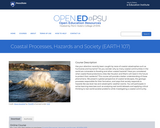
Has your attention recently been caught by news of coastal catastrophes such as hurricanes and tsunamis? Do you wonder why so many coastal communities in the world are vulnerable to flooding and other coastal hazards? Have you considered what coastal flood protections cities like Houston and Miami will need in the future to protect their residents? This course will provide a better understanding of these phenomena. We present a global perspective of coastal landscapes, the geologic processes responsible for their formation, and ways that society responds to hazards like sea level rise and catastrophic weather events. You will participate in active learning exercises such as analyzing real-world datasets and applying critical thinking to real-world societal problems while investigating a coastal community.

In this exercise, students will learn about the environmental review process and identify environmental impacts of a local coastal resiliency project (i.e. ecological, physical/chemical, sociological, economic, and other environmental effects) via supplemental readings and research.
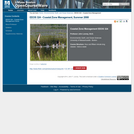
This course will focus upon the geographers bi association of site and situation. The primary goal of the course is to increase the awareness of students through didactic knowledge that is necessary in the planning process. That leads to the course design which in the first part of the semester will focus upon site issues and the last part of the course will focus upon situation issues involving the interactions of the site.
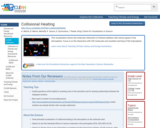
This visualization shows the molecular interaction of infrared radiation with various gases in the atmosphere. Focus is on the interaction with C02 molecules and resultant warming of the troposphere.
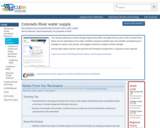
This activity addresses climate change impacts that affect all states that are part of the Colorado River Basin and are dependent on its water. Students examine available data, the possible consequences of changes to various user groups, and suggest solutions to adapt to these changes.
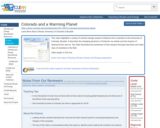
This video highlights a variety of climate change research initiatives from scientists at the University of Colorado, Boulder. It describes the changing dynamics of Antarctic ice sheets and the impacts of reduced Arctic sea ice. The video illustrates the excitement of this research through interviews and video clips of scientists in the field.
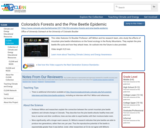
This video features CU Boulder Professor Jeff Mitton and his research team, who study the effects of mountain pine beetle infestations on the forest ecology in the Rocky Mountains. They explain the pine beetle life cycle and how they attack trees. An outlook into the future is also provided.
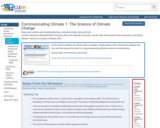
In this activity, students use climate data to develop a simple graph of how climate has changed over time and then present the result in a blog, emphasizing effective science communication.
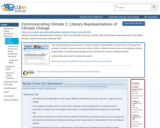
This activity explores how the topic of climate change is represented in various forms of writing, from scholarly articles to opinion pieces and works of fiction. While the content does not emphasize climate science itself, it instead allows students to focus on how the science is being portrayed.
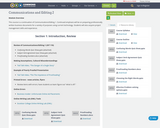
Syllabus and materials for the second half of a course that prepares students to produce professional written business communications. In addition to preparing professionally written business documents for a variety of purposes using current technology, students will acquire project management skills and experience. Includes links to OER readings, videos, and activities.
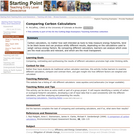
Carbon calculators, no matter how well intended as tools to help measure energy footprints, tend to be black boxes and can produce wildly different results, depending on the calculations used to weigh various energy factors. By comparing different calculators, learners can analyze which ones are the most accurate and relevant, and which are the most transparent.
(Note: this resource was added to OER Commons as part of a batch upload of over 2,200 records. If you notice an issue with the quality of the metadata, please let us know by using the 'report' button and we will flag it for consideration.)
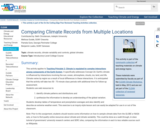
This activity applies to Teaching Principle 2: Climate is regulated by complex interactions among components of the Earth System. It specifically addresses Concept 2A: Earth's climate is influenced by interactions involving the sun, ocean, atmosphere, clouds, ice, land, and life. Climate varies by region as a result of local differences in these interactions. It is anticipated that the activity will take two 50 - 75 minute class periods with additional time for follow-up assessment.
Students use web resources to identify climate patterns and distributions and
synthesize the information to develop an understanding of the global variation.
Students develop tables of temperature and precipitation averages and also identify and describe an extreme weather event. This exercise is an inquiry-style lesson and can easily be adapted for use in or out of the classroom.
Note: Prior to this assignment, students should receive some information on how to sample climate data from the GLOBE or NASA sets, or how to find quality online resources about climate and climate variability. This could be done as a walk-through, in-class tutorial of government/ university research centers and SERC sites, comparing the information in each to less reliable sources such as Wikipedia.
(Note: this resource was added to OER Commons as part of a batch upload of over 2,200 records. If you notice an issue with the quality of the metadata, please let us know by using the 'report' button and we will flag it for consideration.)
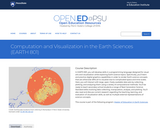
In EARTH 801, you will develop skills in a programming language designed for visual arts and visualization while exploring Earth science topics. Specifically, you'll learn and practice digital graphics capabilities in order to render Earth science concepts that are otherwise difficult to visualize due to complicated space and time scales. Here, you will interact with large, open, freely-available data sets by collecting, plotting, and analyzing them using a variety of computational methods. You'll be ready to teach secondary school students a range of Next Generation Science Standard skills involving data collecting, manipulation, analysis, and plotting. You'll also read and discuss current research regarding the teaching, learning, and evaluation of visualization skills, as well as multiple external representations of science concepts.

This subject is a computer-oriented introduction to probability and data analysis. It is designed to give students the knowledge and practical experience they need to interpret lab and field data. Basic probability concepts are introduced at the outset because they provide a systematic way to describe uncertainty. They form the basis for the analysis of quantitative data in science and engineering. The MATLAB® programming language is used to perform virtual experiments and to analyze real-world data sets, many downloaded from the web. Programming applications include display and assessment of data sets, investigation of hypotheses, and identification of possible casual relationships between variables. This is the first semester that two courses, Computing and Data Analysis for Environmental Applications (1.017) and Uncertainty in Engineering (1.010), are being jointly offered and taught as a single course.